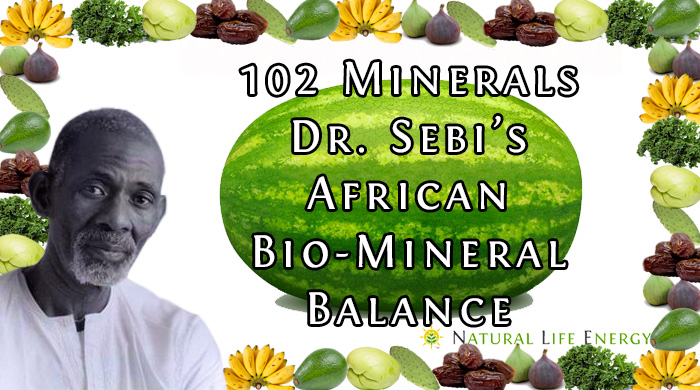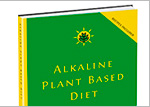102 Minerals In Dr. Sebi’s African Bio Mineral Balance

What Are Minerals?
We should have a good understanding of what minerals are because they are part of the foundation of Dr. Sebi’s African Bio Mineral Balance. The methodology revolves around the 102 minerals Dr. Sebi says the body is made up of and that they need to be replenished through consuming alkaline plant food. There is difficulty in knowing what the 102 minerals are because Dr. Sebi didn’t explicitly state what they were so we have to deduce what they are.
I will first start with complied definitions of what minerals are. First understand that the term “mineral” is an agreed upon concept, which is not totally agreed upon. Generally for something to be concerned a mineral is needs to meet certain criteria including:
A mineral must be a naturally occurring “element” or “chemical compound” formed by geological processes (formation of the earth) and not by biological processes (sea shells). Understanding this concept is important in understanding what Dr. Sebi meant by the term “mineral.” There are over 5000 known naturally occurring compound minerals.
Since there are so many naturally occurring “compound minerals” and Dr. Sebi speaks of 102 minerals making up the body then it would appear he was referring to the elements and not the compounds. Elements are the individual parts of a compound. Iron, phosphorous, and oxygen are individual elements that make up iron phosphate.
An agreed upon criteria for something to be a mineral is it needs to be a solid at room temperature. This is where things can become a little tricky using the term “mineral.” Elements like oxygen, hydrogen, and nitrogen are gases at room temperature and are elements that are part of the air we breathe.
102 Minerals
It is a bit tricky trying isolate which 102 minerals Dr. Sebi referred to because it appears he used the concepts of “elements,” “minerals,” and “compounds minerals” interchangeably. It does appear when he specially spoke about the 102 minerals the body is made of he was referring to elements or single minerals.
An element is an atom made up of a certain number of protons. Every time a proton is added to a atom a new element is formed. For example, hydrogen has 1 proton, carbon has 6 protons, nitrogen has 7 protons, and oxygen has 8 protons.
To support the idea that Dr. Sebi referred to single element when he spoke about 102 minerals I look at the nutrient breakdown of food. Mineral breakdowns are provided for many foods and the mineral content always consists of elements like magnesium, phosphorous, copper, iron, calcium, etc.
There are currently 118 elements listed on the periodic table, but not all of them are naturally occurring and those are made in a lab. Only elements 1-92 are naturally occurring elements except for 43 – Technetium (Tc) and 61 – Promethium (Pm). 43 and 61 have a short half life which are why that aren’t found naturally on earth. 43 has been detected in stars. All elements past 92 -uranium haven’t been found on earth and are made in a lab. http://www.angelo.edu/faculty/kboudrea/periodic/physical_natural.htm
This information makes it difficult to identify which 102 “minerals/elements” Dr. Sebi referred to as making up the body. Either Dr. Sebi was referring to the first 102 elements on the Periodic Table, or he was referring to a combination of elements/single minerals and compound minerals.
-
Periodic Table
- Hydrogen
- Helium
- Lithium
- Beryllium
- Boron
- Carbon
- Nitrogen
- Oxygen
- Fluorine
- Neon
- Sodium
- Magnesium
- Aluminum
- Silicon
- Phosphorus
- Sulfur
- Chlorine
- Argon
- Potassium
- Calcium
- Scandium
- Titanium
- Vanadium
- Chromium
- Manganese
- Iron
- Cobalt
- Nickel
- Copper
- Zinc
- Gallium
- Germanium
- Arsenic
- Selenium
- Bromine
- Krypton
- Rubidium
- Strontium
- Yttrium
- Zirconium
- Niobium
- Molybdenum
- Technetium
- Ruthenium
- Rhodium
- Palladium
- Silver
- Cadmium
- Indium
- Tin
- Antimony
- Tellurium
- Iodine
- Xenon
- Cesium
- Barium
- Lanthanum
- Cerium
- Praseodymium
- Neodymium
- Promethium
- Samarium
- Europium
- Gadolinium
- Terbium
- Dysprosium
- Holmium
- Erbium
- Thulium
- Ytterbium
- Lutetium
- Hafnium
- Tantalum
- Tungsten
- Rhenium
- Osmium
- Iridium
- Platinum
- Gold
- Mercury
- Thallium
- Lead
- Bismuth
- Polonium
- Astatine
- Radon
- Francium
- Radium
- Actinium
- Thorium
- Protactinium
- Uranium
- Neptunium
- Plutonium
- Americium
- Curium
- Berkelium
- Californium
- Einsteinium
- Fermium
- Mendelevium
- Nobelium
- Lawrencium
- Rutherfordium
- Dubnium
- Seaborgium
- Bohrium
- Hassium
- Meitnerium
- Darmstadtium
- Roentgenium
- Ununbium
- Ununtrium
- Ununquadium
- Ununpentium
- Ununhexium
- Ununseptium
- Ununoctium
Elements/Single Minerals:
-
Reference List[1] of
- Oxygen 65%
- Carbon 18%
- Hydrogen 10%
- Nitrogen 3%
- Calcium 1.5%
- Phosphorus 1%
- Potassium 0.35%
- Sulfur 0.25%
- Sodium 0.15%
- Chlorine 0.15%
- Magnesium 0.05%
- Iron
- Fluorine
- Zinc
- Silicon
- Rubidium
- Strontium
- Bromine
- Lead
- Copper
- Aluminum
- Cadmium
- Cerium
- Barium
- Iodine
- Tin
- Titanium
- Boron
- Nickel
- Selenium
- Chromium
- Manganese
- Arsenic
- Lithium
- Cesium
- Mercury
- Germanium
- Molybdenum
- Cobalt
- Antimony
- Silver
- Niobium
- Zirconium
- Lanthanium
- gallium
- Tellurium
- Yttrium
- Bismuth
- Thallium
- Indium
- Gold
- Scandium
- Tantalum
- Vanadium
- Thorium
- Uranium
- Samarium
- Beryllium
- Tungsten
Elements Recorded In Body
-
Common List
- Oxygen 65%
- Carbon 18%
- Hydrogen 10%
- Nitrogen 3%
- Calcium 1.5%
- Phosphorus 1%
- Potassium 0.35%
- Sulfur 0.25%
- Sodium 0.15%
- Chlorine 0.15%
- Magnesium 0.05%
- Iron
- Fluorine
- Zinc
- Copper
- Iodine
- Selenium
- Chromium
- Manganese
- Molybdenum
- Silicon
- Strontium
- Bromine
- Aluminum
- Lead
- Cobalt
- Vanadium
- Arsenic
Elements/Minerals In Body
[1] Emsley, John, The Elements, 3rd ed., Clarendon Press, Oxford, 1998
[2] H. A. Harper, V. W. Rodwell, P. A. Mayes, Review of Physiological Chemistry, 16th ed., Lange Medical Publications, Los Altos, California 1977.







